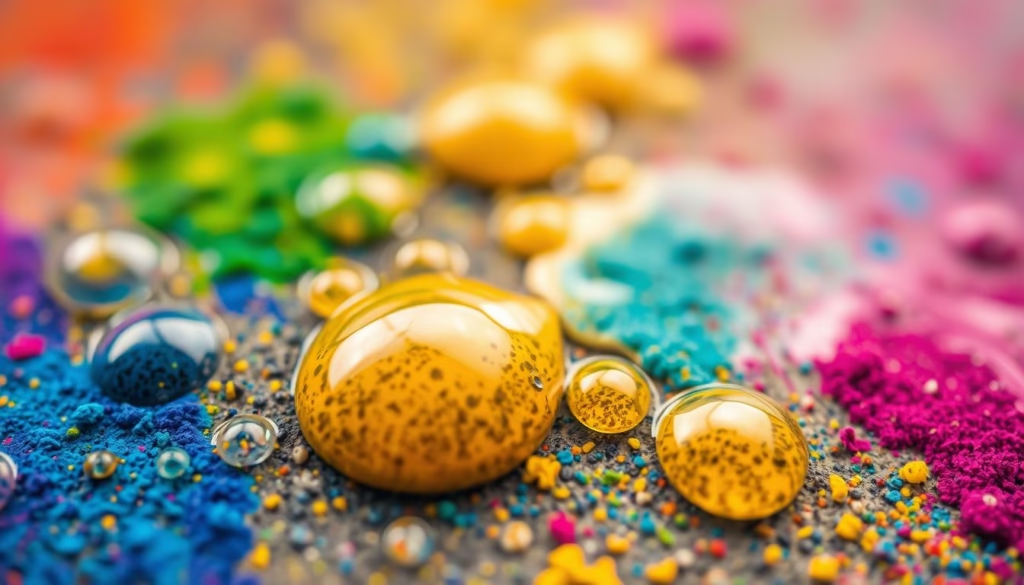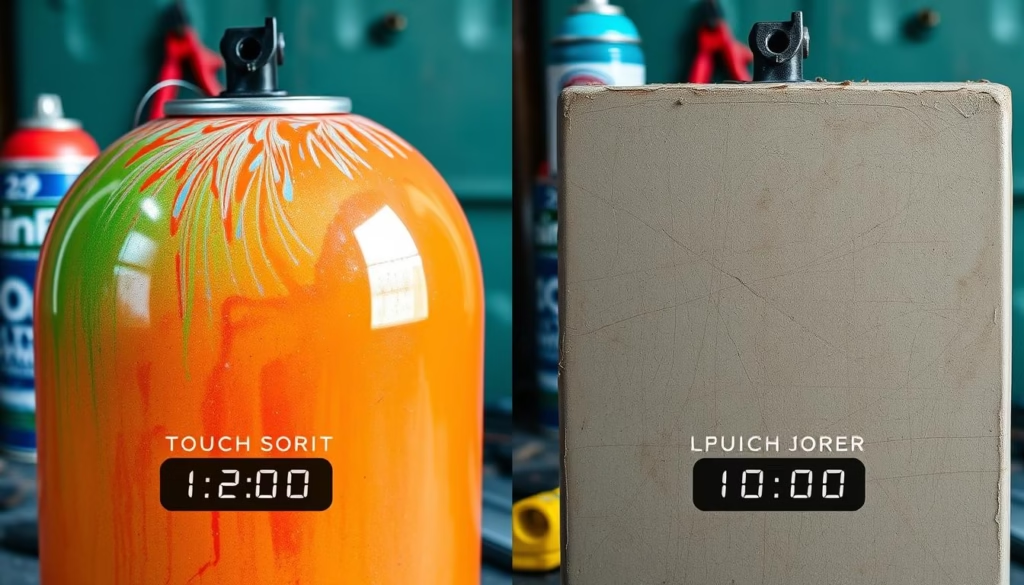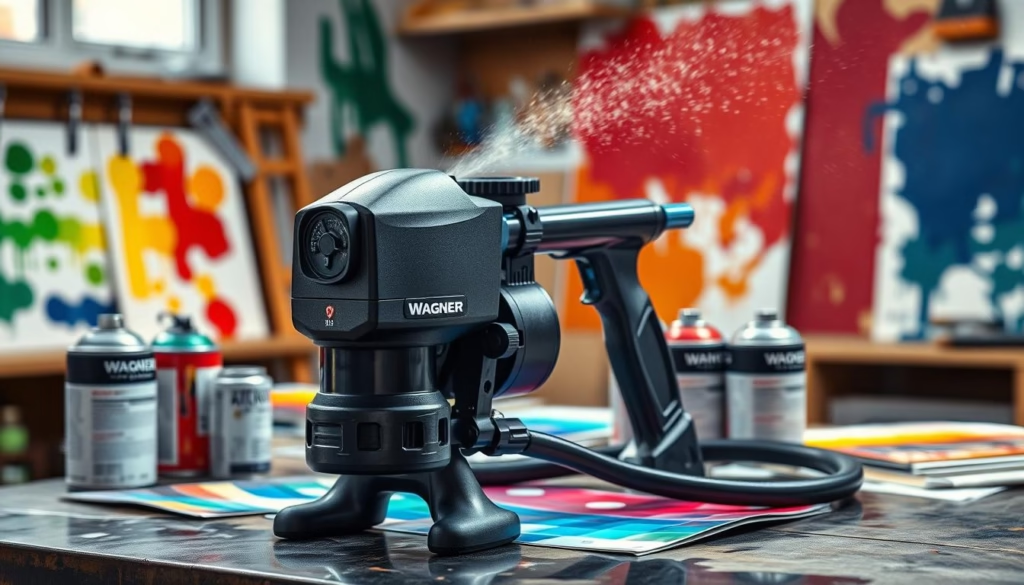Do you want to make old furniture look new or freshen up your walls? You might wonder, how long does spray paint take to dry? The time it takes can change a lot, based on several things. We’ll show you how to get the best spray paint finish. You’ll learn about different paints and how to use them right.

Key Takeaways
- Spray paint drying times can range from as little as 10 minutes to several hours, depending on the type of paint and environmental conditions.
- Understanding the differences between oil-based and water-based spray paints is crucial for achieving the desired drying time and finish.
- Factors such as temperature, humidity, and proper application techniques can significantly impact the drying process.
- Knowing the distinction between touch-dry and fully cured paint is essential for handling your freshly painted projects.
- Expert tips and troubleshooting strategies will help you overcome common drying issues and get the job done right.
Understanding Different Types of Spray Paint
Spray paint comes in many types, like a colorful palette. Each type dries differently and affects how you use it. Let’s look at the main differences and see how some brands dry.
Oil-Based vs. Water-Based Formulations
Oil-based spray paints last long and look shiny. They dry slowly. Water-based paints dry fast and look flat. They’re good for quick indoor jobs.
Common Brands and Their Drying Properties
Different brands dry at different rates. Flame Blue dries fast because it’s high-pressure. Montana Gold takes longer because it’s low-pressure.
High-Pressure vs. Low-Pressure Options
- Flame Blue is high-pressure. It sprays fast and dries quickly. This is because it doesn’t pool on the surface.
- Montana Gold is low-pressure. It covers evenly and dries a bit slower. It’s great for detailed work.
Knowing about spray paint types helps you choose the right one. It ensures your project dries well.
Factors Affecting Spray Paint Drying Time
Many things can change how fast spray paint dries. Knowing these can help you get a smooth finish.
The temperature is very important. Spray paint dries quicker when it’s warmer. But, if it’s cool, it takes longer. So, work in a place with the right temperature.
Humidity also matters a lot. When it’s too humid, paint dries slower. Try to keep the humidity between 30-50% for faster drying.
How thick you apply the paint is also key. Thin layers dry faster than thick ones. Always follow the maker’s advice and use light, even coats.
The surface material you’re painting can also affect drying time. Some surfaces, like metal, take longer than others. Knowing this helps you plan better and get better results.
By thinking about these factors and adjusting how you apply the paint, you can make sure it dries well. This lets you finish your projects quickly and quietly. And you can use a non-metal ball to make it even quieter.
| Factor | Impact on Drying Time |
|---|---|
| Temperature | Higher temperatures accelerate drying, while cooler temperatures prolong the process. |
| Humidity | High humidity levels slow down drying, while low to moderate humidity conditions promote faster drying. |
| Paint Thickness | Thinner coats dry faster than thicker applications. |
| Surface Material | Certain surfaces, like metal and glass, may require longer drying times compared to porous materials like wood and plastic. |
“Understanding the key factors that influence spray paint drying time is essential for achieving professional-looking results and completing your projects efficiently.”
How Long Does Spray Paint Take to Dry: Average Drying Times by Surface
When spray painting, knowing how long it takes for paint to dry is key. This is true for metal, wood, plastic, glass, or ceramic. Knowing the drying time helps you plan and ensures the paint dries right. Here’s a quick guide for each material.
Metal Surfaces Drying Duration
Metal surfaces dry the fastest, usually in 30 minutes to 2 hours. The exact time depends on the paint, temperature, and humidity. For best results, let the paint dry and cure for at least 24 hours before touching or using the metal.
Wood and Plastic Drying Periods
Wood and plastic take longer, drying in 1 to 4 hours. These materials are porous, so paint needs more time to set. Wait until the recommended drying time is up before touching or using the painted surface.
Glass and Ceramic Time Requirements
Glass and ceramic take the longest, drying in 2 to 6 hours. These materials need more time for paint to bond. For the best results, let the paint cure for at least 24 hours before using the glass or ceramic.
These times are general, and drying times can vary. Always check the paint’s instructions for the best drying times. Knowing these times helps you plan and get a perfect finish.
Temperature’s Impact on Drying Process
Temperature is very important when spray paint dries. Knowing how temperature affects drying helps you get better results.
The best temperature for spray painting is between 65°F (18°C) and 85°F (29°C). At these temperatures, the paint dries well and evenly. But, temperatures outside this range can change drying time and quality.
Cooler Temperatures Slow Drying
Cooler places, below 65°F (18°C), slow down spray paint drying. The paint takes longer to dry, leading to problems like tackiness and uneven coverage.
Warmer Temperatures Accelerate Drying
But, temperatures above 85°F (29°C) make paint dry too fast. This can cause an uneven finish or “orange peel” texture. Also, very hot conditions can make paint dry before it levels out properly.
To get the how long does spray paint take to dry just right, watch the temperature. You might need to use heaters or air conditioning. Or plan your painting for the best weather.
“The temperature of the application environment is one of the most critical factors in determining the drying time of spray paint. Understanding and maintaining the optimal temperature range is key to achieving a professional-looking finish.”
Humidity Levels and Their Effect on Paint Curing
Humidity levels are key when spray painting. The air’s moisture affects how fast paint dries. It also changes the paint’s finish quality.
Optimal Humidity Conditions
The best humidity for spray painting is 30% to 50%. At this level, paint dries well and looks smooth. Humidity outside this range can cause problems like longer drying times and uneven paint.
Managing Indoor Humidity
Painting indoors means controlling humidity. Use a dehumidifier to lower air moisture or a humidifier to raise it. Good air flow, like opening windows, helps paint dry faster.
| Humidity Level | Impact on Spray Paint Drying |
|---|---|
| Below 30% | Paint may dry too quickly, leading to a rough, uneven finish and increased risk of cracking or peeling. |
| 30-50% | Optimal humidity range for proper paint curing and a smooth, durable finish. |
| Above 50% | Paint may take longer to dry, increasing the risk of paint runs, sagging, or even mold growth. |
Knowing the right humidity and managing it helps your spray paint dry well. This leads to a finish that looks professional and lasts long.
Proper Spray Paint Application Techniques
Learning how to spray paint is key for great results. It’s true whether you’re doing a big project or a small DIY job. Knowing the right techniques means your surfaces will look even and smooth.
Keeping the right distance from the surface is very important. Hold the wagner paint sprayer 6-12 inches away. Make sure it’s parallel to the surface for the best results. Don’t spray too close, or you might get drips and uneven paint.
- Move the sprayer in a steady, sweeping motion. Go from side to side in overlapping passes. This makes the paint layer even.
- Put on thin coats, letting each dry before adding the next. This stops runs and sagging, giving a pro finish.
- For corners and edges, change how you hold the wagner paint sprayer. This helps cover those tricky spots evenly.
When using a wagner paint sprayer, prepare the surface well. Also, clean the equipment after you’re done. This care will help you get the best results and make your wagner paint sprayer last longer.
Mastering these spray painting tips and using a wagner paint sprayer can make your projects look amazing. Always be safe and follow the maker’s instructions when using spray painting tools.
Common Mistakes That Extend Drying Time
Using spray paint can make surfaces look new fast. But, some mistakes can slow down drying. Knowing and avoiding these mistakes helps get a smooth finish quickly.
Thickness Issues
Applying too much spray paint is a big mistake. Thick coats take longer to dry. For quick drying, use thin, even layers. Let each layer dry before adding more.
Surface Preparation Errors
Not preparing the surface right can also slow drying. If the surface isn’t clean and ready, paint won’t stick well. This can cause peeling or slow drying. Always clean and sand the surface before painting, following the instructions.
By avoiding these mistakes and following the right steps, your project will dry fast. This lets you see the great results of spray paint sooner.
Using Spray Paint in Different Weather Conditions
The weather affects how long spray paint takes to dry. It’s important to know how to spray paint in different weather. This helps get the best results.
Tackling Hot and Humid Conditions
In hot and humid weather, spray paint dries slower. The air’s moisture makes it harder for paint to dry right. Here’s how to fix it:
- Apply thinner coats and wait longer between layers.
- Use a dehumidifier or open windows to control humidity.
- Choose paint that dries fast, even in hot and humid air.
Navigating Cold Weather Challenges
Cold weather makes spray paint dry even slower. The air is colder, so paint dries slower. Here’s what to do:
- Warm the paint cans before spraying.
- Use thinner coats for faster drying.
- Try paint accelerators to dry faster.
- Use a space heater to keep your area warm.
Adjusting your spray painting for different weather helps. This way, your spray paint dries well, no matter the weather.
Professional Tips for Faster Drying Times
When you’re wondering how long does spray paint take to dry, experts have some tricks. They help make your paint dry faster and last longer. You can use these tips to speed up your spray paint projects.
Accelerating Methods
Using a fan is a great way to make paint dry faster. It blows away the paint’s solvents, helping it dry quicker. Also, painting in thin layers works better than thick ones. This way, the paint dries faster.
Try making the room warmer. Warmer air makes paint dry quicker. You can use a heater or a heat lamp. Just don’t get the paint too hot.
Ventilation Strategies
Good air flow is key for quick paint drying. Open windows or use fans to move the air. This helps the paint dry faster. Don’t work in a small, stuffy space.
Using a dehumidifier can also help. Dry air makes paint dry faster. Too much moisture slows down the drying process.
These tips can make your paint dry much faster. Just remember to stay safe and follow the paint’s instructions for the best results.
Touch Dry vs. Fully Cured: Understanding the Difference
Knowing the difference between “touch dry” and “fully cured” is key when spray painting. It’s important to understand these stages. They help you know when your paint is ready to handle and when it’s fully strong.
The touch dry stage means you can lightly touch the paint without leaving a mark. This usually takes 30 minutes to an hour. But, it doesn’t mean the paint is ready for heavy use or more coats.
The fully cured stage is when the paint is fully dry and strong. It takes 24 to 72 hours, depending on the paint and where you are. At this point, the paint is at its best for lasting and not getting damaged easily.
“It’s important to be patient and allow the spray paint to fully cure before subjecting the surface to heavy use or additional coats. Rushing the process can lead to disappointing results.”
To make your spray paint project a success, always follow the drying times given by the maker. Knowing the difference between touch dry and fully cured is crucial. It helps you get a great finish and keeps your surfaces safe for a long time.

Essential Safety Measures During Drying
When using spray paint, safety is very important. Good air flow, protective gear, and ways to lower noise help. They make painting safer and your project a success.
Ventilation is Key
Make sure the air moves well while drying. Open windows, use fans, or make a cross-breeze. This keeps the air fresh. Don’t work in small, closed places. Wear a good mask to keep your lungs safe.
Protect Yourself
Wear goggles, gloves, and long sleeves to protect your skin and eyes. how to silence spray paint with a non metal ball makes less noise. It makes working more comfortable.
- Use a non-metal ball to silence the spray paint can during the drying process.
- Ensure the work area is well-ventilated and monitored for fumes.
- Wear a respirator or mask to protect your lungs from VOCs.
- Avoid wearing loose clothing that could get caught in the spray paint equipment.
By following these safety steps, you can make a safe space for painting. This ensures your project goes well without worries.
“Safety should always be the top priority when working with any type of paint, especially spray paint. Taking the right precautions can make all the difference in the world.”
Troubleshooting Common Drying Issues
Dealing with drying problems in spray paint can be tough. But don’t worry, we have solutions for two big issues: tackiness and paint runs.
Tackling Tackiness
If your spray paint feels sticky after drying, there are reasons. Check the weather. High humidity or cold can slow drying.
Make sure you work in a place with good air and the right temperature and humidity.
Another reason for tackiness is using too much paint. Use thin, even coats for quick drying. If you used too much, sand lightly and apply a thin layer again.
Preventing Paint Runs
Paint runs can mess up your work. To avoid them, spray evenly and keep moving. Don’t spray too much or too little at once.
If you get runs, clean them up fast with a cloth. Then, sand and spray again in thin layers.
Fixing these drying problems will help you get a perfect spray paint finish on your projects.
Specialized Drying Equipment and Tools
Having the right tools for spray painting is key. It helps get a pro finish fast. Learn about the tools that make your painting with a twist projects shine. And see how your wagner paint sprayer works best.
Heat lamps speed up paint drying. They use infrared heat to dry paint fast. This is great for big areas or hard spots to reach.
High-powered fans also help paint dry quicker. They blow air to dry paint faster. This is good for projects needing many coats.
- Drying racks are vital. They keep painted items off the ground. This helps air move well and prevents sticking.
- Special tools like sponges and stencils let you create cool textures. Try new ways to make your paint stand out.
With the right tools, your painting with a twist projects will impress. Your wagner paint sprayer will work wonders, saving time.

“The right tools can make all the difference in transforming a simple spray paint project into a work of art.”
Affiliate Disclosure
Some of the links in this article are affiliate links, including those from Amazon. This means we may earn a small commission if you make a purchase through these links, at no additional cost to you. These commissions help us continue to provide valuable content. Thank you for your support!
Conclusion
We’ve looked into how long spray paint takes to dry. We found out what affects it and how to get great results. You now know about the different types of spray paint and the best conditions for drying.
Now you can make sure your spray paint dries well. This lets you move on to the next step easily. Always be patient and careful with spray paint. Rushing can ruin your work.
Whether you’re fixing furniture or starting a big project, you’re ready. The tips in this article will help you get a perfect finish. Use what you’ve learned to make your DIY projects better.
FAQ
How long does spray paint take to dry?
Spray paint drying time varies. It depends on the paint type, surface, temperature, and humidity. It can dry to the touch in 15-30 minutes. But, it fully dries and cures in 1-2 hours.
What are the differences between oil-based and water-based spray paint formulations?
Oil-based paints dry slower than water-based ones. Oil-based paints take 4-8 hours to dry to the touch. They fully cure in 24-48 hours. Water-based paints dry faster, in 30 minutes to 1 hour to touch. They fully cure in 1-2 hours.
How do high-pressure and low-pressure spray paint options affect drying time?
High-pressure paints dry faster. They atomize more, drying quicker. Low-pressure paints dry slower but apply more evenly.
What factors can affect the drying time of spray paint?
Several factors affect drying time. These include temperature, humidity, paint thickness, and surface material. Good ventilation, the right temperature, and the right paint thickness help dry paint faster.
How long does it typically take for spray paint to dry on different surfaces?
Drying times vary by surface: – Metal: 1-2 hours to touch-dry, 24 hours to fully cure – Wood and plastic: 30 minutes to 1 hour to touch-dry, 2-4 hours to fully cure – Glass and ceramic: 15-30 minutes to touch-dry, 1-2 hours to fully cure
How does temperature affect the drying time of spray paint?
Temperature greatly affects drying time. The best temperatures for drying are 65°F to 85°F. Cold or hot temperatures slow drying.
How do humidity levels affect the curing of spray paint?
Humidity is key for curing. The best humidity is 30% to 50%. Too high or too low can cause problems.
How can I properly apply spray paint for faster drying times?
Apply paint thinly and evenly. Use the right distance from the surface. Avoid thick paint. Wagner paint sprayers help with large projects.
What common mistakes can extend the drying time of spray paint?
Mistakes like thick paint, poor surface prep, and bad weather slow drying. Fixing these issues helps dry paint faster.
How can I speed up the drying time of spray paint in different weather conditions?
Adjust your methods for different weather. Use slower-drying formulas in hot or dry weather. In humid or cold weather, use ventilation and heat or dehumidifiers.
What professional tips can I use to achieve faster spray paint drying times?
Use heat lamps or fans for faster drying. Ensure good ventilation. Apply thin, even coats. Allow time between coats.
What’s the difference between touch dry and fully cured spray paint?
Touch dry means the paint is not tacky. But it’s not fully cured. Fully cured paint takes 24-48 hours to reach its best state.
What safety measures should I take during the spray paint drying process?
Always prioritize safety. Use ventilation, PPE, and methods to reduce noise and fumes. This includes using a non-metal ball on the sprayer.
How can I troubleshoot common spray paint drying issues?
For tackiness, check drying time and conditions. To avoid paint runs, use thin coats and don’t over-spray.
What specialized equipment and tools can I use to enhance spray paint drying?
Tools like heat lamps, fans, and drying racks help. They create a better drying environment. Try creative painting techniques for unique effects.

